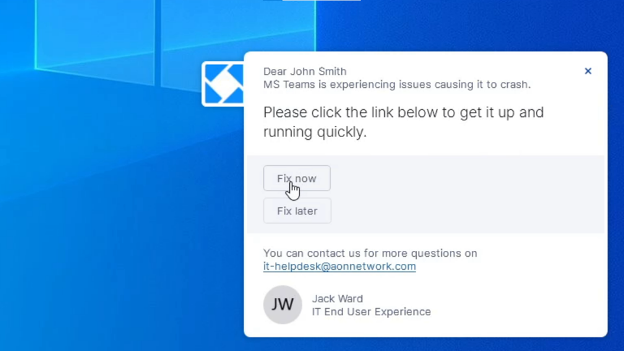Learn how one Financial Institution stopped a flood of recurring IT tickets in its tracks with an automated 1-click fix
When an L1 agent faces a mounting pile of IT tickets, it is hard to be anything but reactive. They need to resolve the issue as fast as possible and restore employee productivity. But when it comes to resolving the same IT ticket over and over again, no Service Desk team should have to do that more than once. Instead, Service Desk agents need to scale incident management across every device in their landscape to reduce or even eliminate recurring IT tickets.
But, Service Desks are often stretched thin, leading to wasted resources, poor IT service delivery and frustrated employees. With IT incidents reaching critical mass, your Service Desk needs to stop repetitive incident management and “Fix one, Fix for all.”
What is “Fix One, Fix for All” When it Comes to Proactive IT?
When the Service Desk resolves common recurring IT issues once and for all through contextual automation, employee self-help, and one-click fix strategies, and utilizes direct integration into ITSM solutions to prevent IT issues from ever becoming IT tickets in the first place.
{Learn More: How to Stop IT Issues Before They Impact Employees}
One Team’s Mounting Recurring IT Ticket Problem
A US-based financial institution’s L1 service desk team was facing a high ticket count – but the real problem was it was often the same issues!
Since the Service Desk had to wait for employees to report issues to fix them, they often had to resolve the same, recurring incidents across different devices repeatedly. Instead of increasing their budget to bring on more resources to keep up with the rising tickets, they used the Nexthink platform to implement a Fix one, Fix for All approach.
How Nexthink’s Device Timeline View Identified the Root Cause of the Issue
When the Service Desk team received a ticket from an extremely frustrated employee complaining about their MS Teams crashing during customer calls, the L1 agent accessed Nexthink’s device user timeline to view and identify that this frustrated employee’s device experienced recent crashes on MS Teams.
In the device user timeline, the L1 agent could clearly see that these crashes started occurring after the Service Desk installed a new binary of Teams on employees’ devices.
Implementing the “Fix One, Fix for All” Approach
With Nexthink, the fix for the L1 agent identified the simple fix– a software rollback!
But, instead of fixing it for just this employee who submitted the ticket, the L1 agent could—in a single click—identify if any other devices had the same issue with this executable.

And, as expected, the L1 agent sees a lot of other employee machines with the same Teams crashing problem!
These employees either did not notice the issue yet or did not report it and were suffering in silence. Either way, the issue would impact employee productivity, and it was only a matter of time before employees submitted more tickets for the very same issues.
The L1 agent knew that the “Fix for One, Fix for All” approach of fixing the issue for everyone impacted was the only way to prevent more incidents, tickets, and employee frustrations.
{Download the free eBook: Evolving from Reactive to Proactive IT}
Targeted 1-Click Fix Resolves Hundreds of Issues in a Matter of Hours
Instead of scheduling individual appointments with each impacted employee or sending an email they may not read, the Service Desk agent sent a targeted pop-up notification to all these impacted employees.

This targeted campaign included a one-click fix, so if the employee clicked yes, Teams would be automatically rolled back to a previous and stable version. The quick notification provided minimal disruption to the employees impacted and enabled employees to resolve their issue and get back to work quickly.
Resolved Issues, Reduced Recurring Tickets, and Happy Employees
Thanks to Nexthink, the Service Desk team gained instant visibility over hundreds of non-reported issues and resolved them before employees could be negatively impacted or submit a ticket.
With this Fix One, Fix for All approach, the number of incoming tickets dramatically reduced, giving the Service Desk a much-needed reprieve and the opportunity to more efficiently use their time to resolve the top issues impacting employee experience.
Related posts:
- 5 Ways to Reduce the IT Incident Backlog Before Your Team Gets Crushed
- 3 Ways to Enhance Your Service Desk With Real-Time Experience Data
- How IT Can Enable Smooth Digital Collaboration | Engagement and Automation
- How Proactive IT Prevents IT Tickets from Reaching Critical Mass